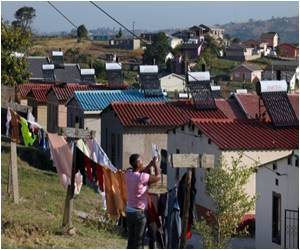It is going to be a bruising battle within the ranks of environmentalists themselves. A US senator is seeking to insulate vast stretches of land on Route 66 from green energy projects.
One of the original U.S. highways, Route 66, US Highway 66, was established back in 1926.The famous highway originally ran from Chicago, Illinois, through Missouri, Kansas, Oklahoma, Texas, New Mexico, Arizona, and California, before ending at Los Angeles, encompassing a total of 3,940 km. It was recognized in popular culture by both a hit song and a television show in the 1950s and 1960s.
Interstate Highway has since replaced the US Highway, but portions of the road that passed through Illinois, Missouri, New Mexico, and Arizona have been designated a National Scenic Byway and named "Historic Route 66."
Now preservationists worried about military expansion and renewable energy development in the California desert are pitching a plan to designate huge swathe of land in the Route 66 region as a national monument.
They also want to protect more than a half-million acres of scattered desert land donated to the federal government as open space but now subject to energy development.
The Wildlands Conservancy, based in Oak Glen, raised about $45 million to buy Mojave Desert land from the Catellus Development Corp., a former arm of the Santa Fe Railway.
Advertisement
While Sen. Feinstein has not endorsed the monument idea, she does plan to ensure the former Catellus land is protected, Feinstein spokeswoman Laura Wilkinson says.
Advertisement
The flurry of moves are coming at a time when the Bureau of Land Management is reviewing 130 applications for solar and wind energy development in the California desert, covering more than 1 million acres of public land. At least 19 projects have been suggested in the area where the monument has been proposed.
Sen. Feinstein said in a Capitol Hill interview Tuesday that she was sending her staff to the desert -- and would probably visit the area herself next month -- to consider what areas should be made off limits to green-energy projects and where they should be permitted.
The area includes desert tortoise habitat, wildlife corridors, cactus gardens and the Amboy Crater -- an inactive volcanic crater where portions of the 1959 movie "Journey to the Center of the Earth" were filmed.
"That section of the road is as pristine as it was when travelers came across it in the 1920s and '30s," said James Conkle, chairman of the Route 66 Alliance.
Feinstein, who regards the 1994 California Desert Protection Act as one of her proudest achievements, noted that the Wildlands Conservancy spent more than $40 million buying the former railroad land in the desert and turning it over to the government in one of the largest land purchases in California history, with the intent of protecting it. "I feel very strongly that the federal government must honor that commitment," she said.
Interior Secretary Ken Salazar said in a letter to Feinstein that projects in the desert would be "carefully considered" before any decisions were made and that "every effort will be made to avoid the most environmentally sensitive and valuable areas." But he also noted that developing cleaner energy sources was a priority.
California Governot Arnold Schwarzenegger said in a speech last year at a Yale University climate-change conference: "If we cannot put solar power plants in the Mojave Desert, I don't know where the hell we can put it."
In November, Schwarzenegger signed an executive order that a third of the state's electricity come from renewable sources by 2020. A major boost in solar and wind power is an essential component of the state's plan to cut greenhouse gas emissions under its landmark global warming law. About 12% now comes from renewable sources, excluding large hydropower plants.
His administration, however, has signaled that it will work with Feinstein. A number of companies pursuing solar or energy projects said they hoped to work with Feinstein to fashion legislation that would satisfy her, environmentalists and the industry.
"It's frustrating. We really do have competing national priorities here," said Paul Whitworth, whose San Diego-based LightSource Renewables hopes to put in a solar project on about 6,000 acres near Amboy. "We spent a lot of time researching the desert, and consulting Bureau of Land Management to make sure we didn't apply on top of an area of critical environmental concern, or area with other issues. . . . Now, there's uncertainty on whether these projects will go ahead."
"What we all know about Sen. Feinstein is that she's long been a champion for both environmental issues and renewable energy issues," said Shannon Eddy, executive director of the Large-scale Solar Assn. "I'm certainly hoping that there's some pathway that we can find here to meet the mutual goals we all have."
A representative of the U.S. Chamber of Commerce who has fought congressional actions to close off areas to oil and gas drilling questioned where energy projects would be built, if not in the remote desert, Richard Simon reported for Los Angeles Times.
"If you're going to take the desert away from us, where are you going to allow it -- Los Angeles?," said Bill Kovacs, the chamber's vice president for environment, technology and regulatory affairs.
Feinstein holds a position of influence: She chairs the Senate appropriations subcommittee that writes the Interior Department's budget.
Source-Medindia
GPL/L








